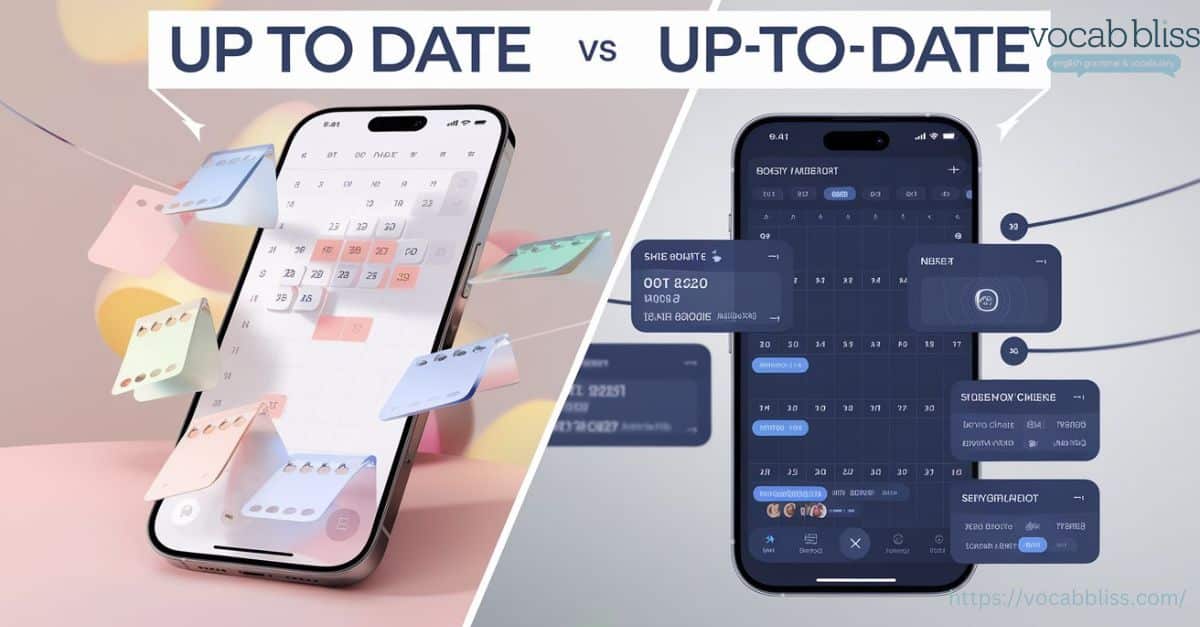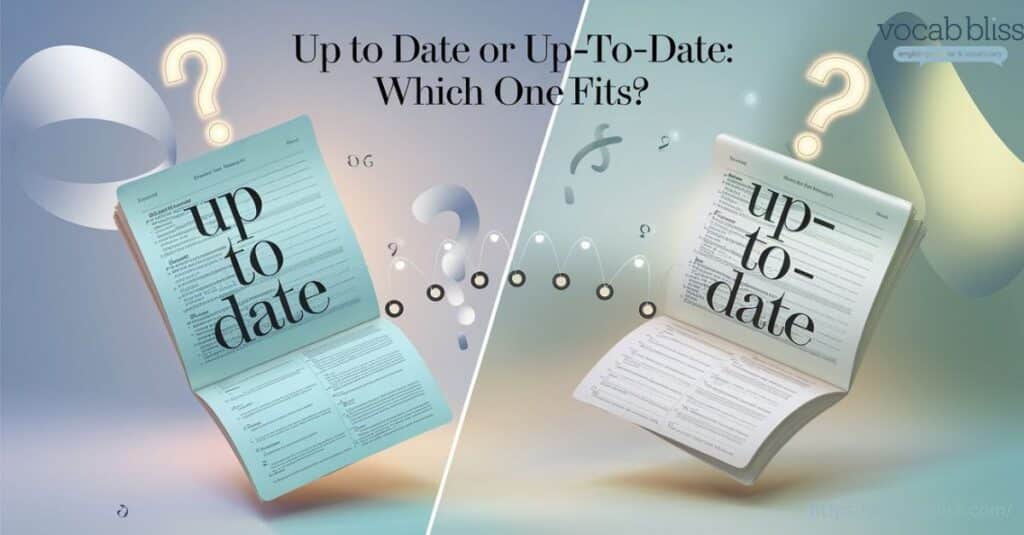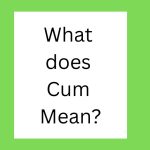In professional writing, attention to detail is vital. One seemingly small detail that can cause significant confusion is whether to write “up to date or up-to-date” This article dives into the differences, proper usage, and why it matters. We’ll also explore synonyms, origins, and examples to help you master this common writing challenge.
Quick Summary
Navigating the differences between “up to date or up-to-date” can be challenging due to their similar appearance but distinct grammatical roles. In essence, “up to date” is used adverbially, describing the action of staying informed or current, while “up-to-date” functions as an adjective, directly modifying nouns to indicate modernity or current relevance. Understanding these nuances is crucial for maintaining clarity and professionalism in both written and spoken communication. By recognizing the proper context for each phrase, you can enhance your writing’s precision, ensuring your message is not only accurate but also engaging and up-to-date in every sense. Whether you’re updating your skills, your website, or your documents, mastering the use of these terms will keep your content both grammatically correct and contextually rich.
Why is There Confusion?
Hyphens play a significant yet often misunderstood role in English grammar, and their application can be tricky, especially when dealing with compound phrases like “up to date or up-to-date.”
The Role of Hyphens in English Grammar
Hyphens are used to join words or parts of words together, creating compound terms that clarify meaning or function. However, they aren’t always required, and their misuse can lead to ambiguity. With phrases like “up-to-date,” the hyphen helps indicate that the words function collectively as a single adjective.
For example:
- “He gave an up-to-date presentation.” (Describes the presentation as current and modern.)
Without the hyphen, the meaning could become unclear, especially in professional or academic writing.
Common Challenges with Compound Phrases in Writing
- Inconsistent Rules:
The English language doesn’t offer a strict, universal rule for every hyphenated term. Writers often have to rely on context and style guides like the Chicago Manual of Style or AP Stylebook. - Contextual Ambiguity:
The same phrase can serve different grammatical roles depending on its placement in a sentence. This duality leads to confusion:- “Keep your software up to date.” (Adverbial phrase)
- “An up-to-date manual is essential.” (Adjective phrase)
- Regional Variations:
British and American English sometimes differ in their hyphenation practices. For instance, British English tends to hyphenate compound adjectives more consistently. - Evolving Usage:
Language evolves with time, and so do spelling conventions. Overuse or underuse of hyphens can affect readability and precision.
Mastering these nuances ensures that your writing is clear, professional, and aligned with grammatical conventions.
What Does Up to Date Mean?
The phrase “up to date” serves as an adverbial phrase, meaning it describes or modifies actions rather than directly describing a noun. It conveys the idea of being current, modern, or informed, often relating to information, trends, or developments.
Definition and Usage as an Adverbial Phrase
“Up to date” is used to indicate that something has been brought to the most recent standard or level. It functions as an adverbial phrase, meaning it modifies a verb, adjective, or another adverb within a sentence. Here’s a formal definition:
- Definition: The state of being current or updated, often referring to knowledge, systems, or processes.
Examples of Usage:
- “Make sure your contact list is up to date.”
- “She worked hard to bring her skills up to date for the new project.”
- “The software must remain up to date to ensure security compliance.”

In each case, the phrase “up to date” modifies the action (e.g., “make sure,” “bring,” “remain”) and explains the condition of being current or updated.
How It Functions Within a Sentence
The phrase typically acts as a complement to a verb, providing additional information about the state or action being described. It is not hyphenated because it functions independently rather than as a compound modifier.
Consider these examples:
- Before the Verb:
- “The team stayed up to date with the latest industry news.”
Here, “up to date” describes the state of the team’s knowledge.
- “The team stayed up to date with the latest industry news.”
- After the Verb:
- “Her certifications are up to date and meet all regulatory standards.”
In this sentence, “up to date” completes the idea of the certifications’ status.
- “Her certifications are up to date and meet all regulatory standards.”
- Paired with Auxiliary Verbs:
- “We need to keep the records up to date.“
The phrase explains the goal or purpose of the action.
- “We need to keep the records up to date.“
What Does Up-to-Date Mean?
The term “up-to-date” is used as an adjectival phrase, meaning it describes or modifies a noun. It conveys the idea of something being modern, current, or in line with the latest developments.
Definition and Usage as an Adjectival Phrase
“Up-to-date” functions as a compound adjective, requiring hyphens to connect its components, which signals that the words collectively describe the noun that follows. This usage ensures clarity and prevents misinterpretation.
- Definition: Having the most recent information, knowledge, or features; modern and current in design, function, or status.
Examples of Usage:
- “The company provides up-to-date technology solutions.”
- “He handed out an up-to-date schedule for the conference.”
- “We rely on up-to-date research to guide our decisions.”
In these examples, “up-to-date” serves as a single descriptive unit, modifying nouns like “technology solutions,” “schedule,” and “research.”
Examples of Its Descriptive Role
- Clarifying Noun Attributes:
- “An up-to-date resume is essential when applying for jobs.”
Here, “up-to-date” describes the resume as being current and relevant.
- “An up-to-date resume is essential when applying for jobs.”
- Highlighting Modern Features:
- “The website boasts an up-to-date interface, making navigation seamless.”
This usage emphasizes the website’s modern and user-friendly design.
- “The website boasts an up-to-date interface, making navigation seamless.”
- Indicating Currency in Time-Sensitive Contexts:
- “The up-to-date weather forecast helped us plan our trip.”
This indicates that the forecast reflects the most recent data.
- “The up-to-date weather forecast helped us plan our trip.”
Key Differences from Up to Date
Unlike “up to date,” which acts as an adverbial phrase, “up-to-date” specifically functions as an adjective. It precedes and directly describes nouns, making it a vital part of precise and professional writing.
Up to Date vs Up-to-Date

Understanding the difference between up-to-date vs up to date is crucial for using them correctly. While the two forms look similar and share a root meaning, their grammatical roles differ significantly. Let’s explore when and how to use each.
When to Use Up to Date
“Up to date” is an adverbial phrase, so it is used to modify verbs or describe actions, conditions, or states. It is not hyphenated because it does not function as a compound adjective.
Guidelines for Using It as an Adverbial Phrase:
- Use “up to date” when you want to describe a verb, state, or condition.
- Place it after the verb it modifies or at the end of the sentence for clarity.
Sentence Placement and Grammatical Considerations:
- “Her knowledge of the industry is up to date.”
(Describes the state of her knowledge.) - “We keep our equipment up to date for optimal performance.”
(Indicates the action of maintaining equipment.) - “Stay up to date with the latest trends by subscribing to our newsletter.”
(Modifies the verb “stay.”)
Ensure that “up to date” is not mistakenly hyphenated when used adverbially, as doing so creates grammatical inconsistency.
When to Use Up-to-Date
“Up-to-date” is a compound adjective, so it always appears before a noun to describe or modify it. The hyphens are essential as they join the words into a single descriptive unit.
Guidelines for Using It as an Adjective:
- Use “up-to-date” when describing or specifying a noun.
- Place it directly before the noun to maintain grammatical accuracy.
Modifying Nouns and Proper Contexts:
- “An up-to-date database is critical for efficient operations.”
(Describes the database.) - “The up-to-date policies reflect the latest industry standards.”
(Modifies “policies.”) - “He shared an up-to-date checklist for the project.”
(Refers to the checklist as current.)
Without hyphens, these phrases could lead to confusion or misinterpretation—making proper punctuation essential for clear communication.
The Importance of Context
Context is key to choosing between “up-to-date or up to date” The sentence structure and intended meaning dictate the correct form.
How Sentence Structure Dictates the Correct Form:
- Use “up to date” when referring to an ongoing state or condition:
- “Is your software up to date?”
- Use “up-to-date” when describing a specific attribute of a noun:
- “This is the most up-to-date version available.”
Common Mistakes and How to Avoid Them:
- Mistake: Using “up-to-date” in an adverbial role.
- Incorrect: “Our team stayed up-to-date with the news.”
- Correct: “Our team stayed up to date with the news.”
- Mistake: Forgetting the hyphens when using it as an adjective.
- Incorrect: “She handed me an up to date report.”
- Correct: “She handed me an up-to-date report.”
Synonyms for Up to Date or Up-to-Date
Finding the right synonym can enhance your writing, making it more engaging and precise. Let’s explore suitable alternatives for both “up to date” as an adverbial phrase and “up-to-date” as an adjective, along with tips for selecting the best option based on context.
Synonyms for Up to Date (Adverbial Phrase)
When you need an alternative for “up to date” to express timeliness or staying current, consider the following options:
- Current
- Example: “Her knowledge remains current in the industry.”
- Updated
- Example: “The software is updated to the latest version.”
- Informed
- Example: “He stays informed about global events.”
- Aware
- Example: “She is aware of the latest trends in fashion.”
- Caught up
- Example: “They are caught up on their coursework.”
These synonyms can replace “up to date” when modifying verbs or describing states, ensuring your writing remains clear and fluid.
Synonyms for Up-to-Date (Adjective Phrase)
For “up-to-date,” which describes nouns, here are alternative adjectives that convey similar meanings:
- Modern
- Example: “The office features modern equipment.”
- Contemporary
- Example: “We implemented contemporary teaching methods.”
- Cutting-edge
- Example: “They use cutting-edge technology in their projects.”
- State-of-the-art
- Example: “The state-of-the-art facility is unmatched in the region.”
- Recent
- Example: “This is the most recent edition of the book.”
- Latest
- Example: “Check out the latest version of the app.”
- Advanced
- Example: “The advanced features make this software unique.”
These adjectives maintain the descriptive quality of “up-to-date” and can be used interchangeably depending on context.
Choosing the Right Synonym
The choice between synonyms depends on the sentence’s context and the level of precision you want to achieve.
Tips for Maintaining Precision and Clarity:
- Match the Grammatical Role: Ensure the synonym fits the phrase’s role in the sentence. For example, use “updated” or “current” for verbs (adverbial) and “modern” or “state-of-the-art” for nouns (adjectival).
- Consider the Tone: For formal writing, options like “state-of-the-art” or “cutting-edge” work well. For conversational tone, choose “recent” or “latest.”
- Maintain Relevance: The synonym should align with the specific meaning. For example, “modern” may not work in all contexts, such as when discussing knowledge or information.
- Use a Thesaurus Wisely: While a thesaurus can provide alternatives, always double-check their usage to ensure they fit naturally in your sentence.
Example Comparison Table:
| Phrase | Synonym | Example |
|---|---|---|
| Up to Date | Current | “The records are current and accurate.” |
| Up to Date | Informed | “Stay informed about market trends.” |
| Up-to-Date | Modern | “We need modern tools for this task.” |
| Up-to-Date | State-of-the-art | “The lab is equipped with state-of-the-art gear.” |
Examples in Context
Understanding how to use “up to date or up-to-date” correctly becomes easier with practical examples. Below, we explore their usage in various contexts to clarify their roles in writing.
Examples Using Up to Date (Adverbial Phrase)
When “up to date” is used as an adverbial phrase, it describes actions or states of being current or informed.
Illustrative Sentences:
- She worked hard to bring her knowledge up to date before the presentation.
- The software must be kept up to date to avoid security vulnerabilities.
- Are you up to date on the latest tax laws?
- The team stayed up to date with the client’s requests throughout the project.
- To succeed in this field, one must remain up to date with emerging trends.
These sentences highlight the phrase’s role in modifying verbs, as they provide information about how or to what extent something is done. Furthermore, they effectively convey the nuances of action and degree, enhancing the clarity of communication.
Examples Using Up-to-Date (Adjective Phrase)
“Up-to-date” functions as an adjective, directly describing a noun to indicate its modernity or current state.
Real-World Examples:
- The company boasts an up-to-date inventory management system.
- This report provides an up-to-date analysis of market conditions.
- Our hospital uses only up-to-date medical equipment for patient care.
- The museum’s exhibit features up-to-date interactive displays.
- Having an up-to-date resume can significantly improve your job prospects.
In each example up-to-date describes the noun it modifies, adding specificity and clarity.
Quick Reference Table:
| Phrase | Role | Example |
|---|---|---|
| Up to Date | Adverbial | “Keep your software up to date.” |
| Up to Date | Adverbial | “Stay up to date with industry news.” |
| Up-to-Date | Adjective | “This app offers up-to-date features.” |
| Up-to-Date | Adjective | “We need an up-to-date system.” |
Origins of Up to Date or Up-to-Date

The history of these phrases reveals their evolution in English.
Origins of Up to Date
- Derived from phrases like “up to the mark” in the 19th century.
- Initially used in financial and academic contexts to mean “current.”
Origins of Up-to-Date
- The hyphenated form gained popularity in the early 20th century.
- It reflected the need for precision in modifying nouns, especially in technical and business writing.
Conclusion
The choice between “up to date or up-to-date” depends entirely on context. Use “up to date” as an adverbial phrase to indicate timeliness. Opt for “up-to-date” as an adjective to describe something modern or current.
FAQs
Does up to date have hyphens?
Yes, but only when used as an adjective (“up-to-date”) to modify a noun.
What is the grammar forup to date?
The grammar depends on its function in the sentence:
- Adverbial phrase: “up to date”
- Adjective phrase: “up-to-date”
What is the difference between up to date and up-to-date?
The main difference lies in their grammatical roles:
- “Up to date”: Adverbial phrase
- “Up-to-date”: Adjective phrase
How do you write the word up to date?
- Without hyphens for adverbial use: “up to date”
- With hyphens for adjective use: “up-to-date”
How can I use up to date?
- Use it to indicate that something is modern or current. Adjust hyphenation based on context.
Is up to date hyphens?
- No, “up to date” is not typically hyphenated. It is generally used as an open compound, with no hyphens.
By following these guidelines, you’ll always know when to hyphenate phrases like “up to date” or “up-to-date,” ensuring clarity and professionalism in your writing.







